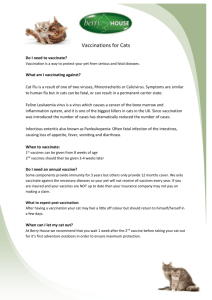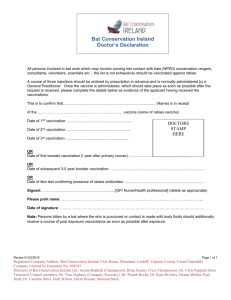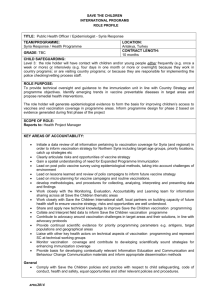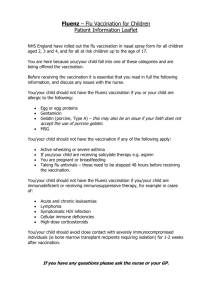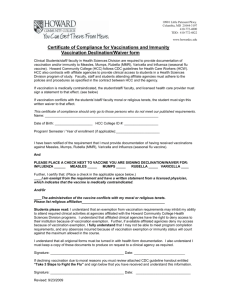Vaccine lesions
advertisement
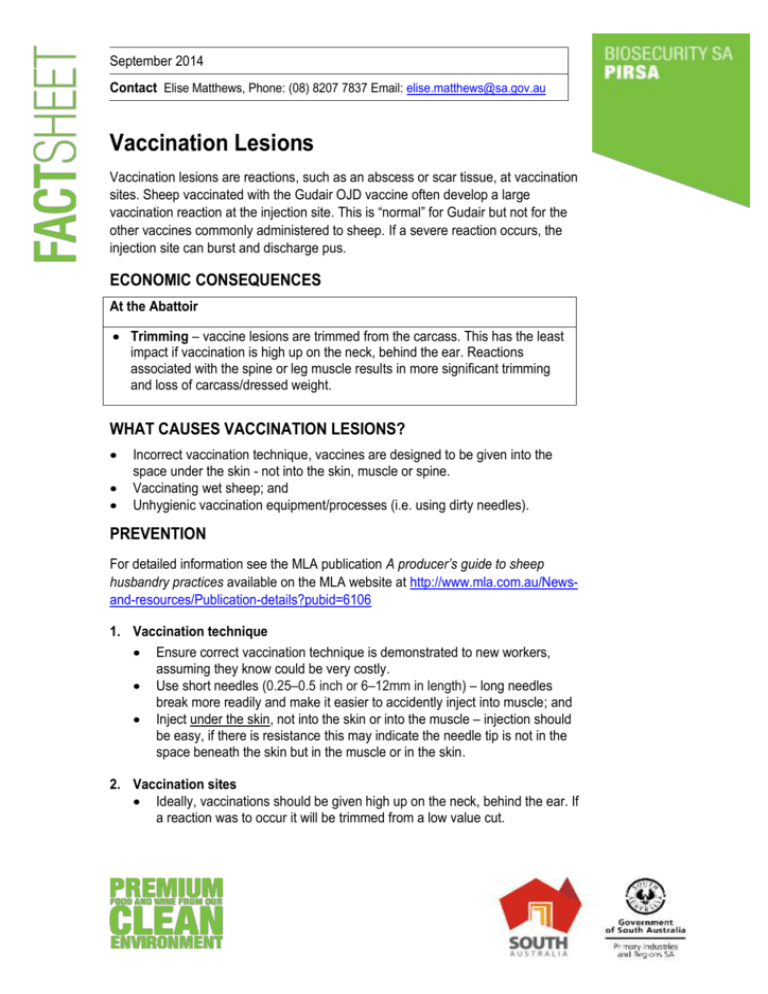
September 2014 Contact Elise Matthews, Phone: (08) 8207 7837 Email: elise.matthews@sa.gov.au Vaccination Lesions Vaccination lesions are reactions, such as an abscess or scar tissue, at vaccination sites. Sheep vaccinated with the Gudair OJD vaccine often develop a large vaccination reaction at the injection site. This is “normal” for Gudair but not for the other vaccines commonly administered to sheep. If a severe reaction occurs, the injection site can burst and discharge pus. ECONOMIC CONSEQUENCES At the Abattoir Trimming – vaccine lesions are trimmed from the carcass. This has the least impact if vaccination is high up on the neck, behind the ear. Reactions associated with the spine or leg muscle results in more significant trimming and loss of carcass/dressed weight. WHAT CAUSES VACCINATION LESIONS? Incorrect vaccination technique, vaccines are designed to be given into the space under the skin - not into the skin, muscle or spine. Vaccinating wet sheep; and Unhygienic vaccination equipment/processes (i.e. using dirty needles). PREVENTION For detailed information see the MLA publication A producer’s guide to sheep husbandry practices available on the MLA website at http://www.mla.com.au/Newsand-resources/Publication-details?pubid=6106 1. Vaccination technique Ensure correct vaccination technique is demonstrated to new workers, assuming they know could be very costly. Use short needles (0.25–0.5 inch or 6–12mm in length) – long needles break more readily and make it easier to accidently inject into muscle; and Inject under the skin, not into the skin or into the muscle – injection should be easy, if there is resistance this may indicate the needle tip is not in the space beneath the skin but in the muscle or in the skin. 2. Vaccination sites Ideally, vaccinations should be given high up on the neck, behind the ear. If a reaction was to occur it will be trimmed from a low value cut. 3. Vaccination hygiene Avoid vaccinating wet animals or vaccinating in dusty, wet or muddy conditions. Use clean, sharp needles. Replace frequently. Don’t let the needle come in contact with dirt – replace any needles that become contaminated or are dropped; and When finished vaccinating ensure equipment is cleaned and disinfected. GENERAL VACCINATION GUIDELINES In order to avoid wasting time and money and to prevent costly disease it is essential that the following is considered when vaccinating your flock: 1. Type of vaccine – ensure the correct vaccination is being used for your enterprise. Do you need a 3-in1 or a 6-in 1? Do you need to vaccinate for arthritis, scabby mouth or OJD? 2. Number of vaccines – ensure product instructions are followed clearly regarding the number of vaccinations required for the initial vaccination course and for yearly boosters. Does the vaccination course require 2 initial doses 4-6 weeks apart followed by a yearly booster? Is the vaccine required once only? 3. Timing of vaccinations – adhere to the appropriate timing of vaccinations. If the second vaccination of a primary course is to be given 4-6 weeks after the first, ensure this occurs. Giving a second vaccination and at the correct time is essential; and Timing of annual boosters is also important for some diseases, for example ewes previously vaccinated with Eryvac needs their annual Eryvac booster 4 weeks before lambing. 4. Be aware of what else has been included in the vaccination Some vaccines contain selenium. You may inadvertently cause toxicity if you are not in a selenium deficient area and a sheep dose is used in lambs or you have also used a drench containing selenium. 5. Ensure appropriate vaccination and equipment is obtained (before yarding) Check vaccine to be used is in date and has been stored correctly. Check to condition of the vaccine gun; and Ensure the vaccine has not become contaminated. FOR FURTHER INFORMATION: Contact the Enhanced Abattoir Surveillance (EAS) Program manager Dr Elise Matthews, your local veterinary practitioner, livestock consultant or local PIRSA Animal Health Officer. FOR ANY SIGNS OF UNUSUAL OR SERIOUS DISEASE, PLEASE CALL THE ANIMAL DISEASE HOTLINE: 1800 675 888


